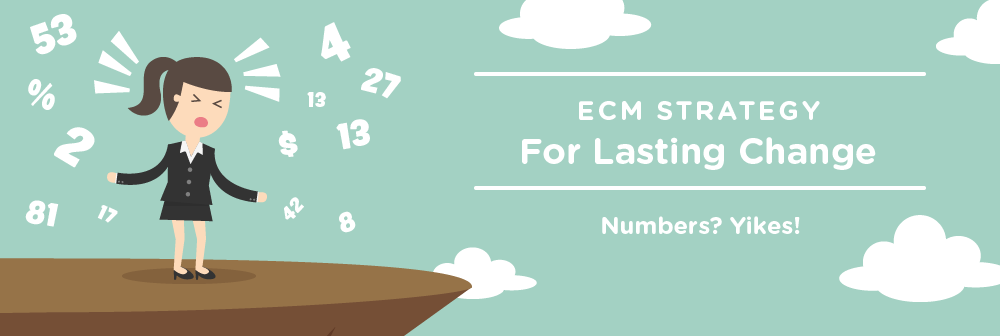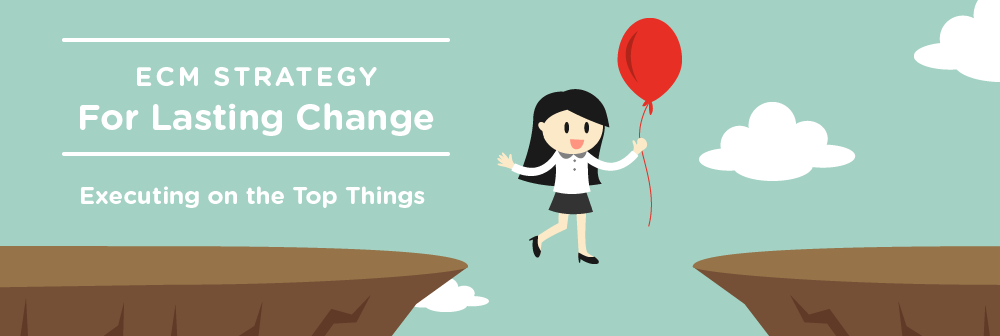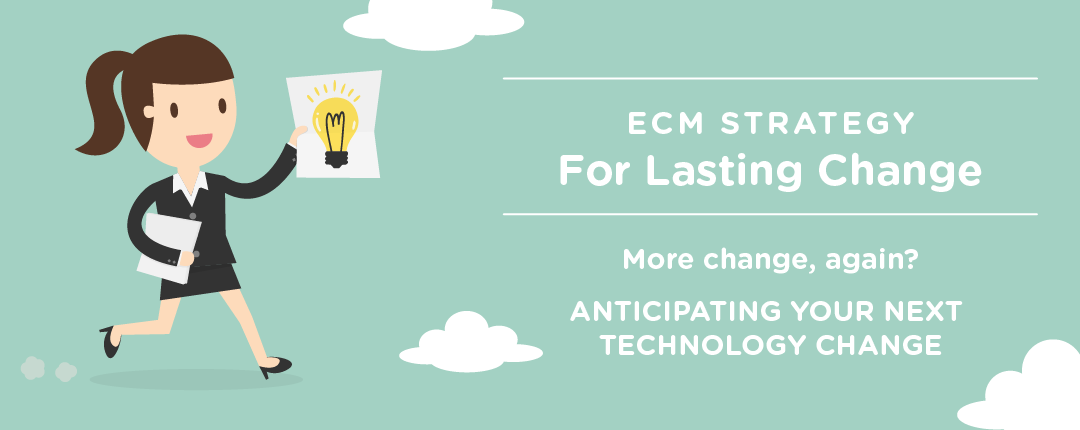Numbers: Measuring the value and success of what’s been done
This article, the third in a five part series on technology strategy techniques that bring about lasting change, discusses using numbers to effectively plan and analyze your ECM. If you haven’t read the series, find the additional posts here.
A wide variety of articles can be quickly found online with ideas and instructions to develop a cost/benefit analysis for an ECM rollout. Most of these articles focus on: 1) initial justification of implementing an ECM system, and 2) a whole lot of numbers in complex spreadsheets consisting of hardware and software expenditures, personnel costs, operations, maintenance and support, and more. Dry and complicated? For sure! But in some organizations, these justifications can’t be avoided and are required to get your ECM project off the ground. The core of these calculations require some analysis of these areas:
- Total benefits:
- Increase: profit, growth, retention, efficiency, visibility
- Decrease: costs, time, effort, complaints, attrition, risk, conflict, duplication, administrative burden, infrastructure
- Project rollout costs
- Mapping benefit and cost projections
- Calculations of financial metrics
If you’re looking for a blueprint for this sort of ROI calculation, you may want to search the web for a useful spreadsheet to get your justification started. In fact, if you run a simple Google search for “ECM ROI,” you’ll find various resources. But, better yet, search for “ECM Myths” and the results will probably show an article titled, The 5 Myths about ECM ROI. While the article was written a few years back, there’s one myth that completely resonated with me and is still relevant today:
ECM ROI Myth: Total ROI for an ECM implementation can be identified up front and accounted for in advance.
Correct! Past the initial project justification, and over the lifecycle of an ECM platform, measurements of value should continue. The continuous value gained from a well-architected and strategically-driven ECM implementation is actually more interesting to measure. It builds momentum in the business and motivates employees.
So, the initial ECM platform implementation should provide cost savings upon rollout—and it darn well better or those folks involved in it may be looking for new jobs! But a well adopted system gains credibility and momentum as it matures, and in turn drives ongoing business process improvements and risk mitigation that may not have been accounted for in the initial calculations of the ROI. The future of the platform and continued funding for operations and enhancements is dependent upon the continuous value of the ECM platform, not just the initial value of it. Therefore, the ROI should be continuously measured. To do that, you need to dig into the details.
Measurement and momentum
In order to illustrate the ways in which a project can evolve from original measures, let’s talk through some examples. In working with a specialty insurance company on an ECM project, the team originally set out to deliver an enterprise-wide ECM. The core of the project was focused on success criteria such as:
- Refresh the content platform technology stack
- Replace functionality 1:1 (do not break how the business works)
- Focus on IT-centric gains (less maintenance and easier supportability)
This criteria (while very high-level) was something the team could justify and measure. It began as a pure ECM focus: capture, manage, store, and provide document access to employees.
As the project progressed, we shifted our focus to critical business process management (BPM) improvements. In other words, we didn’t just refresh the stack and put in a new backend, we focused on streamlining complex business processes, rather than just on storing and accessing content. The original ROI didn’t account for any of those improvements, but the gains were monumental.
Example 1: Mailroom automation and workflow creation
Original Process: The company used to follow a very manual flow of paper through the organization:
- Paper mail received in the mailroom each morning
- Workers opened, sorted, and put mail into the appropriate bins
- Mail was delivered to the departments within the company
These pieces of paper mail were:
- Further sorted by departments
- Delivered to employee mail slots or directly to people’s desks
- Indexed by hand with pen and paper or by hand-entering data into systems
- Stacked up with covers sheets and delivered back to the scan room
- Back scanned (scanned at the end of the process) and queued to be re-indexed electronically
The process was repetitive and inefficient, and managers could not easily redistribute the workload as they lacked good insight into the manual workflow process.
New Process: After the new system was in place, and the business process was re-architected, it is much more streamlined:
- Paper mail arrives in the mail room where it is stacked to be automatically opened and sorted
- Upon scanning, it is ingested into a capture tool (Ephesoft) where it is classified and key data is extracted into metadata fields
- It is then automatically routed into electronic indexing queues in the repository (Alfresco)
- Indexing data is validated which triggers workflows for employees in the system
Now, the process is streamlined and managers have an electronic dashboard of the workflows the employees are working. Redistribution of the workload can be done by reassigning tasks with a few clicks.
Example 2: Storage of documents in appropriate systems
Original Process: Employees upload documents to two (or more) systems, such as the ECM (for retention) and a claims management system (for claim processing).
- Documents may be scanned more than once to be ingested in multiple systems, causing duplication of work (indexing of the documents) and storage into different systems
- If documents were received electronically (via email or fax), a claims adjuster would upload files to multiple systems
New Process: Employees index files with the appropriate metadata once and the documents are distributed as electronic references (links) using integrated content services from the ECM.
- Any documents scanned or received are uploaded and indexed once
- Critical documents are referenced using key metadata in multiple business systems from a single ECM source
Example 3: Documents to be securely shared with external resources
Original Process: Paper forms are sorted and stacked in boxes for a courier to pick up. Daily these documents were picked up, scanned, and processed by a third-party servicer at significant cost to the company.
New Process: Forms of a certain type are classified by Ephesoft and flagged for electronic delivery. Once index data is validated by an employee, the documents are queued for secure, electronic delivery to the third-party servicer. The new process saves courier costs, scanning charges from the third party, and overall time to process.
Summary of ongoing value: what can be measured as the system is maturing is much more compelling:
| Pain Point | Previous Measurement | New Measurement |
| Sort, route, and take required action from paper mail that is received. | Paper mail took hours or days to receive, process, and create actions. | Paper mail is digitally transformed and workflows for new actions are created in less than 15 minutes. |
| Electronic documents stored and duplicated in multiple systems. | Documents are stored in ECM and duplicated in other systems, such as claims management system increasing eDiscovery risks and doubling storage requirements. | Documents are routed and actioned while integrated content services provide links in claims management system to documents in the ECM. This provides a single source of record which reduces risk with simplified records retention and half (or less) of the storage needs. |
| Sharing medical forms and documents with a third-party servicer is time consuming and costly. | A daily courier service picked up and delivered paper documents resulting in significant cost to deliver, scan, and process. | Documents are delivered securely and electronically at a fraction of the cost. |
Reducing the risk that your ECM ROI falls short: Zia adds value
The examples above illustrate a few benefits of the business process improvements that have helped to continually add value and justify ongoing investments in one specific ECM platform. There are more examples, and frankly, more work to be done to continue the success of the ECM platform described above. As we know, overall project failure is truly the biggest risk to your ROI. Zia specializes in rescue projects and remapping expectations to guard against having an ECM project that simply falls short of expectations—original calculations of ROI numbers or ongoing business process driven ones. Zia works with your team to assess and decrease risk. Throughout your project, we work hard to:
- Discover any risks unique to your organization and your project
- Plan and mitigate risk to reduce project issues and minimize impacts
- Determine the best way forward if needing to address any risks (leveraging your team and ours)
- Continuously help you measure and articulate the value your ECM platform provides
Key Takeaways:
Initial ECM ROI calculations may only help you determine: 1) Should we do the project at all? 2) What is the initial investment for the platform? 3) What priority does the project take? It won’t tell you the total ROI over the life of the ECM platform.
Uncovering ongoing value: Discover how the business teams are using and adopting the platform and continually quantify the improvements. If the ECM platform is well architected, there are going to be emerging benefits throughout the enterprise. Finding these and measuring them helps you continue to gain support and momentum for the future of the platform.
Don’t be plagued by risk: The number one killer of ROI is risk—known and unknown. More than any other factors, not addressing risk could result in overall project failure. In addition, never settle for a mediocre ECM platform! Zia can help you succeed, as well as assist in measuring and articulating your success story.
Next time we’ll dig into evolving your platform with your business. Change, change, and more change…





